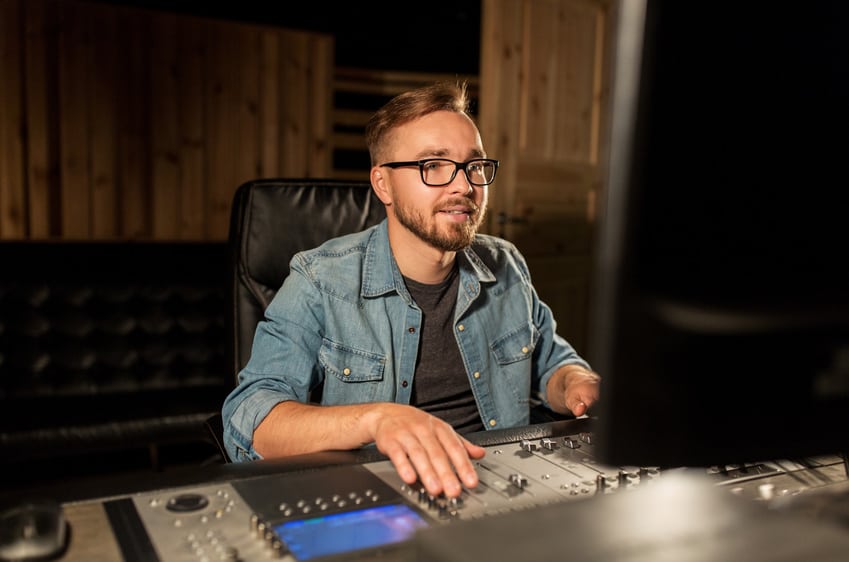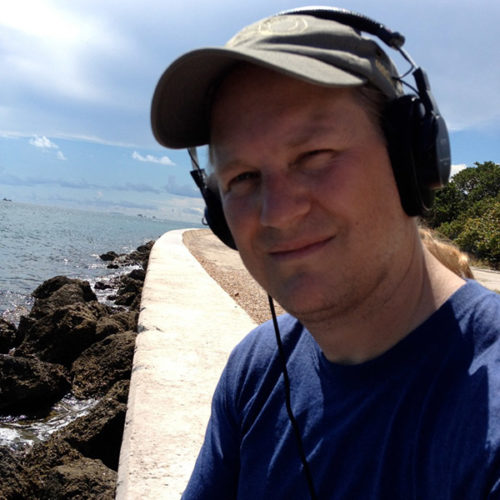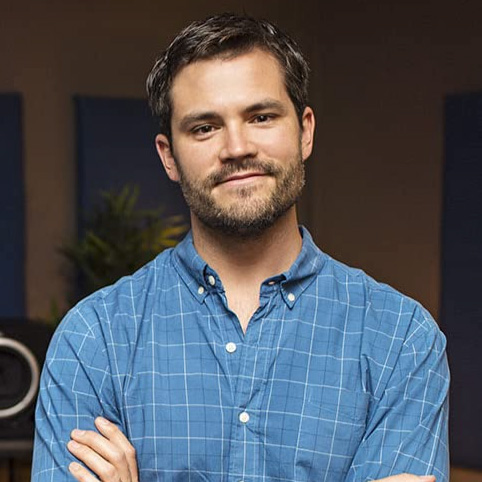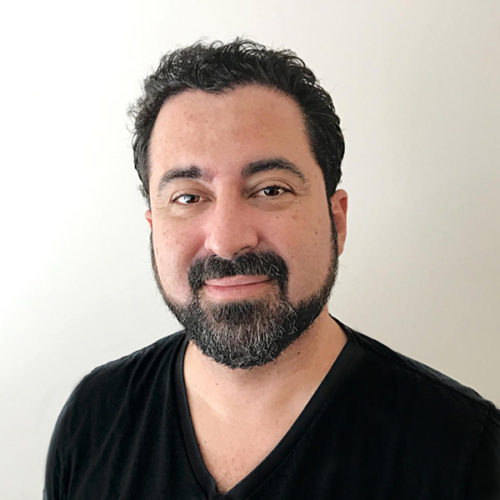Film Career Finder
Start Here:
Sound Designer
Career Overview
The Sound Designer oversees the creative aspects of how a film will feel sonically and what its unified sound aesthetic will be.
Alternate Titles
Sound Editor, Supervising Sound Editor
Salary Range
$68,000-$124,000

How To Become a Sound Designer
- Career Description
- Salary
- Career Outlook
- Career Path
- Experience & Skills
- Education & Training
- Additional Resources
- Sources
Career Description
The Sound Designer is the position in charge of creating a production’s soundscape. Sound Designers oversee the inclusion of all diegetic and non-diegetic sound in a film, television show, commercial, or other form of entertainment.
Diegetic sound is sound inherent to the world of the film, such as dialogue and music emanating from a source in a scene, like a radio in someone’s bedroom or a bar’s jukebox.
Non-diegetic sound is sound that is not part of the world of the film. Examples include narration or a musical score.
Examples of what a Sound Designer might be tasked to do on a film include cleaning up dialogue, adding sound effects, and generally balancing the different soundtracks, including the dialogue, sound effects, and score.
The job of a Sound Designer is to ensure that each soundtrack is in harmony with the others and that the necessary dominant sound in each moment has prevalence.
What does a Sound Designer do? This video explains.
A Sound Designer is key to the success of any film. While they usually don’t gain as much notoriety as Actors and Directors, their contribution is indispensable. Not only do they make sure that the basics like clean dialogue and appropriate sound effects make the world of the film audible and believable, but also they help to convey the more intangible qualities of a film like emotion and atmosphere.
That’s why industry-respected figures like Ben Burtt, Christopher Boyes, David Acord, Gary Rydstrom, and Will Files have become well-known names in the field of Sound Design — they’ve helped shape the emotional impact and atmosphere of some of the most iconic moments.
For a small project such as a short film, a Sound Designer may be a one-person sound department and responsible for all of the sound needs. For larger productions, they’ll head up a team of other sound professionals where those same tasks can be spread out among multiple people.
The day-to-day schedule of a Sound Designer depends on the needs of each project. They are part of the post-production team, so deadlines are determined by the delivery dates set forth by the Director, Producer, or Film Editor.
That being said, for larger productions, the Sound Designer might come on board during even the pre-production phase to ready themselves for the oncoming needs of the project.
A Sound Designer is generally considered a freelance professional, which gives them the option to create their own schedule. If they have the time and energy to do so, they can work on multiple projects at the same time. For instance, because commercials are generally not extremely time-intensive, a Sound Designer might work on two or three at once.
But in most cases, a Sound Designer works exclusively on a feature film they’ve been hired for, as this type of project demands the full attention and detail of someone in their position.
To learn what a career as a Sound Designer is like, we talked to:
- Benjamin L. Cook (Shōgun, Percy Jackson and the Olympians, Monarch: Legacy of Monsters)
- Brandon Jones (The Tiger’s Apprentice, Candy Cane Lane, The Flash)
- Daniel Lepervanche (Arranged Marriage, The Paradigm of Money, Samland)
Salary
According to Glassdoor, the annual average salary for a Sound Designer is $77,875 and typical salary range runs from $68,000 to $124,000. Given that Sound Designers may work several days to weeks on a single project, the cost to hire one may mean several thousand dollars per project.
Because it is a freelance career, every Sound Designer gig typically involves some measure of wage negotiation, which can result in a different amount of compensation each time. Factors such as a professional’s experience, the demands of a particular project, and the turnaround time for it will impact the amount that a Sound Designer receives for a job.
Four-time Oscar-winning Sound Designer Richard King offers his advice to those new to the craft.
A Sound Designer can become eligible to join the Motion Picture Editors Guild, or IATSE Local 700, which includes a wide group of post-production professionals beyond Editors. When a Sound Designer is a union member, they will typically receive more lucrative wages, as they are protected by the salary regulations for union workers on a project.
Career Outlook
The world of film is so visual-centric that the importance of sound can be overlooked by those not in the industry.
But for the Directors, Producers, and others who understand just how vital sound is to the success of their films – and who do the hiring for it – they’re constantly on the lookout for skilled Sound Designers.
So while the contributions of a Sound Designer may not be regularly recognized by the general public, a professional who has shown themselves to be hard-working, talented, and easy to work with will always be in demand.
That being said, it will likely take much time, dedicated energy, and great patience to get to a position where a professional can rely solely on their sound designing work for their livelihood. That is the nature of most every freelance position in film.
For this reason, it’s important that aspiring Sound Designers be proactive in their careers. That means taking on every viable opportunity to grow skillsets and professional networks.
Just like anyone else in the entertainment business, aspiring Sound Designers need to look after their financial well-being. That might mean not always being able to take a low-paying or volunteer gig.
But if the project can help to demonstrate a Sound Designer’s talent and includes other professionals who may be able to get them a paying position in the future, it’s a gig to at least consider.
Another reason to consider taking any opportunity that comes along is because there will be downtime in this profession. If instead that time can be filled with even a volunteer position, when you’re at the career-building level, it can be useful towards building connections, skills, and one’s work reel.
Just how difficult is it to learn sound design? This video explores this vital part of filmmaking.
When on a job, a Sound Designer may find that much of their waking hours are devoted to it. That being said, maintaining some semblance of a work-life balance is important, as burnout is a very real issue for many filmmaking professionals.
As such, an aspiring Sound Designer must be realistic about their capabilities and what they can accomplish in a given period of time. That also translates into being able to communicate with others about those capabilities.
Many professions in the filmmaking industry require strong communication skills, and that of a Sound Designer is no different. While that often means being able to communicate about the project itself, it also includes being forthcoming about expectations and one’s ability to live up to them.
The Sound Designer will typically collaborate with the Director on the latter’s overall vision. They will also get notes from the Producer and Film Editor.
Within their own sound department, they’ll collaborate with the Dialogue Editor, Foley Editor, and Background Editor. They also talk to the Music Supervisor and Composer to make sure all sounds are functioning cohesively.
The professional life of a Sound Designer can be fulfilling both creatively and financially, but it is also a career that requires constant proactivity to maintain the relationships and build the skillsets that will lead to future jobs.
Career Path
Because the craft of sound design is one that encompasses both creativity and technical know-how, often the career path of someone entering this field begins with college, where they can gain a base knowledge of the industry.
Especially with the rapidly evolving world of sound equipment, it can often prove useful to use college as a professional springboard. “A formal education isn’t necessary, but film and music schools will provide an opportunity to learn equipment and software and to foster relationships with like-minded people that often have a long-lasting career impact – it’s a very relational job,” says Cook, who studied at the Musicians Institute: College of Contemporary Music.
College likewise is typically when those looking to become Sound Designers can take on internships to further those skillsets and networking opportunities.
The importance of making solid connections in the film industry cannot be overestimated, as much of this business and the referrals within it come from past colleagues and working relationships.
Filmmakers within any part of the industry can be hesitant to refer someone they’ve never worked with before. So to have the greatest chance of getting that recommendation for a gig, an emerging Sound Designer has to have already made those connections. That means taking on as many viable opportunities as possible as early as possible in one’s career.
Taking on gigs as a Production Assistant in any area of post-production or Assistant to a Sound Designer offer a useful way to observe what happens once a film is “in the can” and the post-production team takes it over. From this vantage point, an aspiring Sound Designer can better understand how the different post departments work together and under deadlines.
These types of opportunities also open the door to potential mentor relationships where an established Sound Designer takes on someone working their way up as an Assistant and gives them the chance to shadow them on jobs to learn more quickly and comprehensively what it takes to be a successful Sound Designer.
Watch in real time as a Sound Designer works his movie magic.
This type of real-world experience can be immensely helpful to someone working their way up to be a Sound Designer.
However, with the wide accessibility of post-production software, regardless of whether someone works in the film industry, aspiring Sound Designers can now more quickly hone their skills as they continue to take jobs in support roles on their path to becoming a Sound Designer.
Whether through self-education or a growing resume of smaller gigs, an aspiring Sound Designer can begin to build their reel of work that will hopefully gain attention and get them future jobs with more seniority and responsibility.
Many major cities like Vancouver, Atlanta, and Houston have growing production communities where aspiring Sound Designers can be successful. Moreover, now more than ever many facets of post-production, including sound design, can be done remotely from anywhere across the globe.
That being said, the more established production locales like Los Angles and New York still remain the most popular places to be, as that’s where the bulk of the work remains. Plus, even if a client is largely fine with their Sound Designer working remotely, they may still want face-to-face time to initially discuss the project and have periodic meetings.
Experience & Skills
No matter what area of filmmaking a person works in, their colleagues want to know that they are dependable and will get their job done.
Because so many people are largely unfamiliar with what goes into sound design, it becomes all the more important for a Sound Designer to instill confidence in others that they are competent and qualified for the job.
That means having examples of prior work to show a potential client, which can only come from past experience. Again, while building a career, this is exactly why it’s so important to take on any jobs that one can feasibly do while also looking after their everyday needs.
With experience comes not only greater skill in terms of creativity and technical expertise, but also quickness. Unfortunately, the post-production world is often rushed. Clients want yesterday what you said could be done only today.
While a more experienced Sound Designer might come with a higher wage rate, clients might agree to that higher rate because they have more confidence in the Sound Designer’s ability to deliver what needs to be accomplished in the timeframe provided.
How important is sound design really? This video demonstrates the storytelling impact of this part of filmmaking.
So in addition to being proficient in the latest sound-specific post-production equipment and keeping fresh that creative spirit that’s vital to any project, a Sound Designer who wants to have a long and productive career in this industry must also handle the sometimes demanding time constraints of projects and work well under those pressures.
Speaking of creative spirit, it’s important for Sound Designers regardless of their time in the industry to remain inspired to do their work well. Getting that inspiration often comes from watching movies with interesting and unexpected sound design. “Like Guitar Players learning to shred by listening to records and playing to the greats, deconstruct and redesign your favorite film scenes, trailers, video games, or any other audiovisual content you might be leaning towards,” says Lepervanch.
This creative drive follows Sound Designers like Brandon James in their day-to-day life. “I always have a handheld recorder with me wherever I go,” he explains. “If I hear something cool and interesting, I just record it and catalog it in my sound library. A lot of the time, I have no idea what I would ever use it for… If you can forget where the sound came from, it opens the door to use sounds that you would never really expect would work for a certain scene in a movie.”
A great Sound Designer must also know how to collaborate and parse out what their colleagues might be looking for even if they aren’t able to articulate those wants.
Sound Designers translate the emotions filmmakers want an audience to feel into sound. They need to not only be creative in their approach to Director notes, but also be able to explain why they made the choices they did for every single component of their soundscape.
To help grow and strengthen these skills, here are some helpful tips:
- Learn Pro Tools, which is an industry-standard software program.
- Listen to different environments and imagine how you’d artistically represent them.
- Research successful Sound Designers and try to get an internship at their post-production companies. Without overstepping boundaries, try to get in touch with them to ask about any potential work opportunities such as internships or PA opportunities.
- Watch – and listen to! – movies. With your eyes closed, can you still understand the story being told?
Education & Training
If someone is looking to begin their career as a Sound Designer with college, they can generally pursue one of two options.
They might decide to attend a school with an audio production/recording program. This type of program can provide a highly detailed level of learning for aspiring Sound Designers with sound-specific classes that cover topics like signal flow, recording software, microphone choice, and so on.
Seeing with your ears is one way to describe sound design in film. This video offers a look at how the role of it has transformed and heightened many of Steven Spielberg’s most memorable movies, including Munich.
Because of the growing acknowledgement of just how important sound is to the overall experience and success of a film, many film schools now provide specialized programs for students who are looking to enter this sector of the movie business.
While they will receive an education fairly focused on sound design and its role in filmmaking, aspiring Sound Designers can also learn about all the many other facets of making movies, such as directing, producing, and even screenwriting, that can all help to strengthen one’s perspective as it relates to their specific medium of sound design.
Additional Resources
Daniel Lepervanche recommends this excellent Los Angeles Times article on how to start a career in sound design.
The Association of Sound Designers, or ASD, has an online archive of past seminars that can be viewed about all aspects of sound design.
Lynda.com and YouTube may also have decent sound design tutorials. There are also Facebook groups like Sound Design and Sound Design Only that can be great resources.
Even online sites such as Masterclass can prove beneficial to aspiring Sound Designers who are looking for free or low-cost options to develop their understanding of sound design.
Sources

Benjamin Cook
A 20+ year veteran in the post sound industry. He has worked at or for all the major studios and several independent facilities in Hollywood. A 10 time Emmy Award nominee–winning 4. He has also been nominated for a CAS award for his mixing work on Westworld, and several MPSE Golden Reel Awards. In 2006, Apocalypto was nominated for an Academy Award.
“I was introduced to Post Production taking a part-time job at night transferring 1/4” production sound rolls, while pursuing a music career in Los Angeles. A love of movies and my interest in samplers (sampling) and midi keyboards served me well. I had already been using time code to synchronize tape machines to various midi devices (drum machines and keyboards). So, it wasn’t a huge leap to synchronize a DAW to a 3/4” deck. My first job cutting sfx was on Hercules – The Legendary Adventures and its spin-off Xena – Warrior Princess. Twenty years later my love affair with technology and sound continues. I have been very fortunate to work on great projects balancing work in both television and film.”
Notable Television credits include Deadwood, Rome, The Pacific, Black Sails, Lost in Space, Jack Ryan, Westworld….and most recently The Old Man. Film credits include Apocalypto, Secretariat, Spiderman: Homecoming, and Spiderman: Into the Spiderverse.

Brandon Jones
Brandon Jones is a Sound Designer, Sound Supervisor, and Re-Recording Mixer based in Los Angeles. He grew up in Chicago, then moved to LA to pursue a career in music. He studied classical guitar at Pepperdine University with world-renowned Guitarist Christopher Parkening, then earned his Masters’s in guitar performance at USC. It was years later that he moved into the film industry, doing sound design and mixing for small independent projects, eventually working his way up to feature films. He has been fortunate enough to work on such films as A Quiet Place, Godzilla vs Kong, Jungle Cruise, Detective Pikachu, The Shallows, Sonic the Hedgehog, and many more.

Daniel Lepervanche
Daniel Lepervanche was born in Venezuela, raised in Miami, and is a proud Los Angeles resident. An accomplished Music Director, Composer, Sound Designer, and Re-Recording mixer, he has over ten years of professional experience in music and sound post-production.
Daniel has had the honor of working with award-winning music companies, sound houses, and creative agencies on projects for major motion picture studios such as Paramount Pictures, Warner Bros., Disney, Sony Pictures, Fox Studios, NBCUniversal, and Netflix; production companies such Freemantle, and Endemol Shine Group; videogame developers such as Activision, Cygames, and Netmarble; and brands such as McDonald’s, Diesel, Powerade, Snickers, and Honda.
Furthermore, he holds a Bachelor’s and a Master’s degree in Music Technology, and being fluent in Spanish has allowed him to work with diverse teams, multicultural content, and global campaigns.